Records of tagged Elephant Seals observed at Race Rocks.
For Tagged Elephant Seals recorded in our log from 2010-2013– etc. see https://racerocks.ca/tag/tagged/
We often encounter marine mammals in the reserve which have been marked when trapped in another location as part of a scientific study. Numbered brands are the most common indicator on sea lions and numbered tags are common on elephant seals. For example: G6360 R-il-So (R-il-So) refers to the position of the tag in the flipper – R=right, il=inner lower webbing, So=spike out). Having this detailed position information (along with sex) helps with identifying the seal when the last digit of the tag becomes unreadable.We are including in this file a set of pictures of marine mammals which have been tagged in various studies, along with the particulars of the observations. A link to theTOPP website , Tagging of Pacific Predators, has information about a program run out of Año Nuevo , including tagging of elephant seals. Information supplied on the elephant seals tagged below was provided by Patricia Morris (See note at end of this database:)
MR=Mike Robinson ( Ecoguardian)
AF=Alex Fletcher ( Ecoguardian)
JB= Julie Bowser (summer Ecoguardian)
PB= Pam Birley (observer from England)
You can also see the Ecoguardian’s notes and images in the Race Rocks Log
Previous photos and observations of tracking devices prior to 2011can be seen in this file:
RECORDS FOR 2010-12
For a general search of tagged entries in the log click here:
Green tags on elephant seals come from Año Nuevo (Piedras Blancas = White, San Miguel Island and Santa Rosa Island = yellow, San Nicolas Island = Red, SE Farallon Island and Point Reyes = Pink)
| Date | Tag………. Colour and number |
History1…………….. | History 2 …………………….. | Photo 1…… | Photo 2……… |
| May 05/13 | Green 6360 | Also reported May | |||
| Dec 15 2012 |
green 6397 |
Also reported by Mike in the spring of 2012 | no photo | ||
| Dec 15 2012 |
green 6375 |
 |
|||
| Nov 9 2012 |
green 7225 |
 |
|||
| Nov 6 2012 &Jan 29, 2013 see log |
pink N-472 |
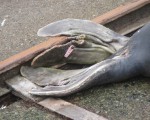 |
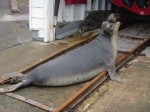 |
||
| June 21 2012 | double green 6322/ 4849 |
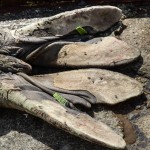 |
|||
| June6 2012 |
green 6355 |
#6355 hauled out in boathouse, undergoing juvenile moult. |  |
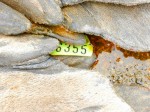 |
|
| April 29 2012 |
green 6375 |
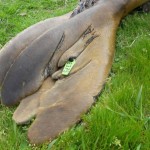 |
|||
| April 29 2012 |
green 6355 |
See notes from Patricia below on Jan 8 2012 |
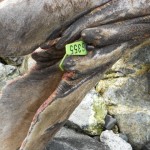 |
||
| April22 2012 |
green double 5086/ 4665 |
G5086/G4665, was tagged at Año Nuevo mainland. She was born 13,Jan 2011, the daughter of G2234, an 8 year old born at Año Nuevo in 2003. and she has at least 2 half-sisters that we know of. She was weaned 8 Feb 2011 and was a medium-large weaner. |
This is her first sighting since she departed from Año Nuevo in spring 2011. She looks like she is at a good weight and her ‘shabby’ coat is normal for yearlings. | 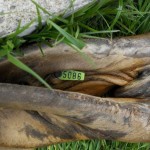 |
|
| Jan 9 until Mar 22 2012 |
green X948 |
GX948 L-iu-So was tagged as a female weaner on 27 Jan 2011 on Año Nuevo mainland. It looks like she was seen on 9 Jan 2012 at Race Rocks |
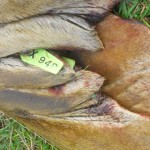 |
||
| Jan 8 2012 |
green 6355 |
G6355 R-il, also tagged 29 Mar. 2011 on Año Nuevo mainland, also a female weaner. It looks like she was seen at Race Rocks on 8 Jan. 2012 and again on 17 & | 23 Mar. 2012 and we’d call her a yearling at this point. We give all the seals a birthday for age classification purposes on 1 Jan. since the vast majority are born in Jan. & Feb. | 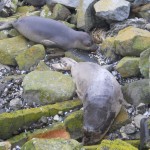 |
|
| Dec 5 2011 |
green 6360 |
G6360 R-il-So (R-il-So refers to the position of the tag in the flipper – R=right, il=inner lower webbing, So=spike out). Having this detailed position information (along with sex) helps with identifying the seal when the last digit of the tag becomes unreadable. |
It looks like this seal was seen on 5 & 6 Dec. 2011 on Race Rocks. She was tagged as a weaner on 29 Mar. 2011 at Año Nuevo mainland, so she was about 11 months old when you saw her. |
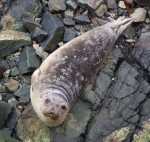 |
|
| Dec 5 & 6 2011 |
green 4252 |
She was tagged as a weaner on 28 Mar. 2011 at Año Nuevo mainland, so she was about 11 months old when you saw her | see June2, 2010 record also |
no photo | |
| Oct 17 2011 |
TOPP 6375 |
no photo | |||
| June2 and 26 2010 |
green 4252 |
Tagged at Año Nuevo mainland on 28 Mar. 2009 as a female weaner. It looks like she was seen as a yearling 2 & 26 Jun.2010 and was perhaps injured on 26 Jun. (coughing blood). |
She could have been injured by a bull e-seal. They sometimes break a female’s or juvenile’s ribs while attempting to mate. She has not been seen at Año Nuevo since she left in spring 2009. | no photo | |
Note from Patricia Morris, Research Coordinator, UC Natural Reserve, Año Nuevo COH/Long Marine Lab, Santa Cruz, California, 2012. “For all of these elephant seals, these were their first sightings since they departed Año Nuevo in spring the year they were born and we’re glad to get the information that they are alive and well and living in BC. While we have vast amounts of information about the migratory patterns of adult female e-seals and a fair amount of information about adult or nearly adult males from dive computers and satellite telemetry we mount on their backs, we have only minimal information about the young seals making their first trip or two to sea. As with most large wild animals, the juveniles suffer 50%+ mortality in their first year and since it happens at sea, we don’t know the causes (predation?, failure to find food?) or the locations where they die or the strategies of the successful juveniles. We do at least know that they generally go north from sightings such as yours.”
